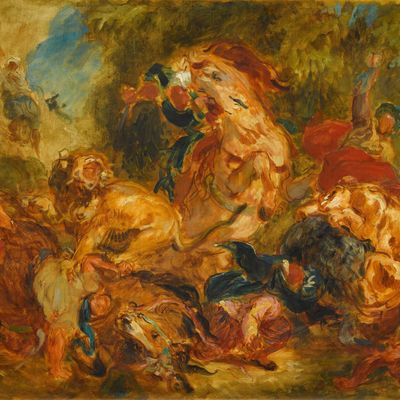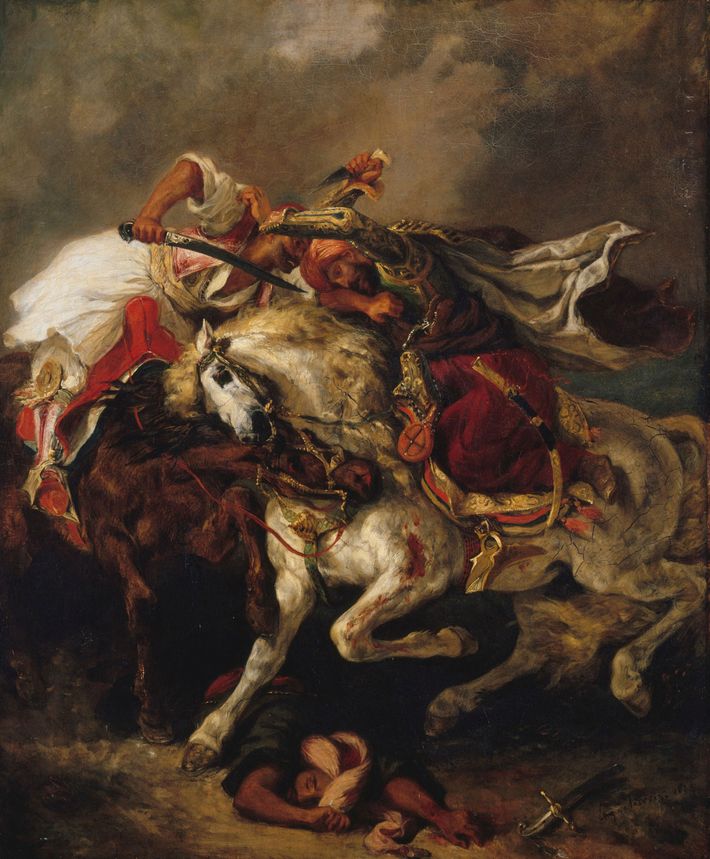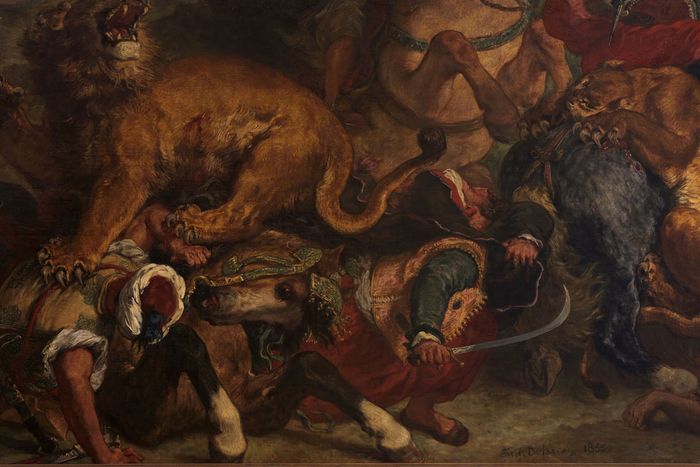
Prepare to grapple with the cosmic grandiosity and optical hot-messes of that 19th-century French freak of painterly nature, Eugène Delacroix, who’s churning, turgid, crimson-tinged floridity has enkindled the respiratory systems of artists since he first debuted at the Paris Salon of 1822 — and given many others agita.
Now, at the Met, comes the first large-scale North American retrospective of his epoch-altering work. How did it alter his epoch? Delacroix’s style is so uncontained, convulsive, and atmospheric it’s hard to pigeonhole as simply Romanticism. At times I often look at his painting and mourn the death of his extraordinary comrade, Théodore Géricault, he of the 1819 Raft of the Medusa, as this artist might have made French Romanticism less flamboyant and easier to take had he not died before the age of 33. Delacroix pushed much harder, which means that his work is more demanding and hard to digest, even now, but, as a result, he is one of the most influential artists of the last two centuries.
What do you see when you look at a Delacroix? Fuzziness, smears, fibrillating paint, irradiated color that destabilize space and emulsify objects. The technique fuses the Italian, Flemish, and Spanish painterly dash of Titian, Rubens, and Velázquez. His art also points directly at Cezanne, Manet, Gauguin, Renoir, and van Gogh (all of whom name-checked him in painting titles) and then to Matisse, Soutine, De Kooning, Frankenthaler, Marlene Dumas, and Kara Walker. Cezanne exclaimed, “You can find us all in this Delacroix.” Legendary gallerist Peter Nagy recently wrote, “We owe all of 20th century painting to Delacroix. And 21st century too.”
Yet by the time he died, Delacroix was already something of an anachronism, seen more as a painter-patriarch of the grand manner, a last old master. The artists who followed him quickly moved on to collectively create Realism, Impressionism, and Post-Impressionism — styles that are Grand Canyon–sized gaps from his sensibility. Delacroix said artists “must look within,” and pointedly painted the stuff of the imagination, rather than engaging directly with subjects of the world, choosing from Dante, Shakespeare, Byron, Goethe, and Walter Scott. The last entry in his notebooks (must-reads for aspiring artists) declares that painting should be “a feast for the eye,” and one admiring contemporary critic wrote his large paintings were about “paint and nothing more” which would lead eventually to the idea of “art for art’s sake.” But the younger artists of Delacroix’s time wanted to paint the weight of the world; they turned to everyday scenes, subjects, people, and places. Think of Courbet’s Stone Breakers, Millet’s Gleaners, van Gogh’s shoes, Monet’s Parisian scenes, Manet’s 1863 Luncheon on the Grass (painted the year Delacroix died). Delacroix painted from and for art history; the new generations were making history paintings of modern life.
Before we look at what’s here and importantly what’s not, a few biographical notes to let us know where he’s coming from and maybe why he got ensnared in ideals of ages gone by. Born in France in 1798, Delacroix is a true son of the revolution. His father was foreign minister in the revolutionary government; his older brother a general in the Napoleonic Army. Everything was on the rise for the young artist when his life took a drastic turn. He was orphaned at 16 and soon lived in near poverty. This explains why, even though his style is revolutionary, Delacroix’s politics are steeped in far more moderate values and tempered by fears of loss. He was committed to a French Republic; he portrayed the barricades better than anyone before or since, but he never fought on them. After the three-day July Revolution of 1830 that saw the overthrow of the Bourbon King Charles X and the installation of Louis Philippe, cousin of King Louis XVI, two of his most important patrons were not only high government officials, one was Talleyrand, another was the despised archconservative prime minister Adolphe Thiers. His art education was being apprenticed to the neoclassicist Pierre-Narcisse Guérin — who was also training Géricault. Delacroix also devoured all the new masterpieces looted by Napoleon from all over Europe and Africa and now installed as trophies in the Louvre.
Under Guérin, Delacroix came to loathe the smoothed-over, finicky fussiness, blended paint, and affected poses of neoclassists like Ingres and David. For him this kind of work was lifeless, a waste of labor, the display of mere dexterity. “Cold exactitude,” he wrote, “is not art.” Amen! Instead, Delacroix wrote of the “pleasure in vagueness.” We may say that he touched Vagueness Sublime.
Over 150 prints, drawings, watercolors, paintings, and manuscripts fill 12 galleries at the Met. Because much of the work is small we don’t get the wide-open retinal fireworks of his big pictures. Which is a small shame; Delacroix himself wrote “small paintings…bore me.” (Of course they were good for the market.) So rather than having our toes curled by his huge optical painting machines, here narrative, tighter composition and brush-handling predominate. This can really wear you down. See Hamlet in the graveyard (with one foot already in the grave), Michelangelo brooding in his studio, literary and biblical scenes, and of course all those scenes of stallions, warriors, and lolling odalisques. There’s also a lot of work on paper here, and while it’s pleasurable to peruse this material, we don’t come to Delacroix for his line and draftsmanship. On the contrary, one of the things that make his paintings so extraordinary is that there’s almost no drawing in them at all. Instead he’s continually winging it with paint, making it up as he goes, mixing varnishes, viscosities, wet-on-wet application, and importantly deploying what he called “flochetage” — interlaced strokes of complimentary colors that combine in the eye to heighten hue. Flochetage leads directly to Impressionism, Post-Impressionism, Seurat, and Signac. Van Gogh described it as “color seeking life.”
Unfortunately, only flashes of this sublimity illuminate this show. The galleries are painted an adumbral-shade of aubergine — which instantly puts his work back in the crypt. There are only about a dozen large paintings here. Fortunately, one of them — Women of Algiers in Their Apartment — is a world-class, history-changing, discomforting Orientalist masterpiece. This lack of large works isn’t the fault of the Met. No Delacroix survey outside France can feature his gigantic showboats — some as big as barges, others painted on the ceiling of Parisian museums and former palaces. But before we take a close look at the above-mentioned painting, and the final three galleries where the show finally flowers with a handful of paintings displaying some of his all-out giddily swirly flourish, several things to know about four of the monuments that didn’t make the trip.
In his debut in the Salon of 1822, Delacroix exhibited Barque of Dante, an enormous canvass depicting the poets Dante and Virgil being ferried across the infernal River Styx while writhing dead souls and sinners reach up from the murk to grab or gnaw this vessel. Dante recoils in horror and the infernal city of Dis blazes in the tinged distance. Salon crowds instantly grasped the feelings the painting portrayed. This was a generation, after all, who, like Delacroix, had lived through the French Revolution, death, destruction, the beheadings of the king and queen, Robespierre, the Reign of Terror, the guillotine, Napoleon’s rise, France as empire, Napoleonic wars, the decimation of Europe, and the total defeat of the French army. The country was then subjugated by the allies and saw the unthinkable restoration of a Bourbon King. Censorship was back; there were no widespread voting rights at all. These people knew what it meant to live in uncertainty, famine, and chaos; going through hell was something they knew in their bones. Delacroix gave them all this in theatrical fashion, removed it from actual events (unlike Raft of the Medusa) and did it in rougher, looser, intensely colored paint mixtures that had ever been seen in the world before. They loved it.
The crowds, that is. The big biennial Paris salons had been the domain of elites, yet in a very modern way, Delacroix intentionally side-stepped authorities, teachers, the academy and decided to play directly to the crowds, using the salons as platforms to wow them. Delacroix knew what he wanted and why. “Fame,” he wrote at 26, “is not an empty word for me … the sound of praise gives me real happiness.”
Two years after the Barque of Dante, writing that he wanted to “set myself apart,” he pushed the envelope further in a huge strange picture of a contemporary Ottoman massacre of Greek freedom fighters, women and children. This was Scenes from the Massacres at Chios. Critics called it hideous, barbaric, and coarse; viewers wondered if the paint was glue or putty and accused Delacroix of having an “out-of-control imagination.” (He did!) The famous Neo-Classicist Antoine-Jean Gros deemed the work a “massacre of painting.” The show’s excellent catalog says the work represents a “semantic slippage from painting’s subject to its form; [one that] reduced the public’s apprehension of the painting to its materiality.” This means Delacroix provided no real story or narrative, just disconnected figures, shapes, forms, paint. Crowds complained of being denied “the possibility of penetrating beyond the foreground.” This is a perfect observation of this work’s relentlessly modern frontality.
In his next major work, this unreadability reached its apotheosis. The Death of Sardanapalus is a vertiginous painting said to have “neither top nor bottom … the school of the ugly.” This gyrating composition depicts the last act of corruption, despotism, and sadism of an Assyrian king lounging atop a huge red bed, staring detachedly as murder, rape, and destruction are carried on all around him — all of it ordered by him rather than having himself captured by invading armies outside the burning window. It’s one of the most punch-drunk pictorial hallucinations in Western art — precarious perspective and volatile open space dominate the middle of the painting, things tumble around and out of this almost-abstraction of flesh, turbans, decoration, blood, knives, elephant sculpture bedposts, horses stabbed by slaves. It’s still a mystery how this titanic nowhere-ness holds together at all.
Finally in our roll call of the missing is one of the most reproduced images of all time, July 28, 1830: Liberty Leading the People (1830). If you’re thinking that painting isn’t like those other three, you’re right — much more than a radical style, Delacroix dialed back and offered radical content. It worked, and secured his place in history and people’s hearts. Included in the 1831 Salon, it famously depicts an allegorical figure of a bare-breasted female Liberty in perfect Roman profile. She boldly strides the Paris barricades, tricolor flag raised in her right hand, rifle held in the other, surrounded by armed students, workers, tradesmen, and businessmen atop rubble and bloody dead bodies. One is a pantless male, apparently dragged out of his bed and killed in his nightshirt — his pubic hair shows, which scandalized crowds. In the place of the burning City of Dis, however, is a tiny Notre Dame displaying the blue, white, and red flag of Liberty.
It would be among the last times Delacroix painted something inspired by current events. (It’s like he did this to free himself forever of ever having to do it again.) France bought the painting and it was slated it to one day hang in the Louvre. Two years later, the timid government of Louis-Philippe deemed the painting too dangerous to be publicly exhibited and put into storage. Liberty was not seen again in public until around the time of the next revolution of 1848. By then it was already a legend. Today the figure of Liberty has been used in more illustrations and political cartoons than can ever be counted. Delacroix was all of 33 years old and the most famous painter in the world. He remained that for the rest of his life. At his funeral, however, was only a small contingent of dedicated artists.
Among them were Manet; Baudelaire, his lifelong champion, who delivered a eulogy; and Henri Fantin-Latour, who would paint his famous Hommage a Delacroix, a group picture (now hanging in the Musée d’Orsay) of militant young artists and writers, including himself, Manet, and Whistler — all surrounding a painted portrait of Delacroix.
Now you have the tools to visit the Met, look at what’s here and know about what’s not. I recommend first making your way to the seventh gallery of the exhibition where the aforementioned blockbuster Women of Algiers in Their Apartment is installed. This loan from the Louvre has mesmerized, inspired, and flummoxed artists ever since.
Delacroix painted Women only two years after Liberty. Yet structurally it rushes forward to the implacable, un-enterable scrimmed-and-plaited space of Courbet and Cezanne and the bejeweled incandescence of Seurat and Matisse. Women is beyond narrative and real logic and is closer to a hashish dream or entering a cathedral and taking in atmosphere, ambience, temperature. Delacroix called it akin to “beautiful verses.”
It’s real and unreal, seen, imagined, reassembled, made up with African and Caucasian models. In 1832, Delacroix was brought by the government on a diplomatic mission to Northern Africa. The light, spaces, colors, costumes, architecture, and “living antiquity” of the place put a fix on his brain that changed the course of his art. From here on out, we see more voluptuous color and scenes of otherness.
Women came about on the return voyage, when Delacroix finally gained entry inside a Muslim household. (He had been allowed inside Jewish households before then, but never Muslim.) The memory of that moment is what he tried to paint in Women of Algiers in Their Apartment. Yes, it’s an Orientalist portrayal of the other that will make some skins crawl, anger many people, and will strike many others as creepy male fetishization and fantasy. There’s no doubt that a deeper content of the painting, like almost all such works of these places at this time, is colonialism — be it insidious, unconscious, callous, or otherwise. In addition to all this, Women is a monumental genre scene, pointedly not a harem, brothel, or slave market. The women aren’t naked, nude, lascivious, seeking approval, being bought and sold, or performing. Dressed in Algerian-style chemises, arm braces, and jewelry, they are grouped around a glowing brazier and a hookah. The plain interior is marked by a Venetian mirror, decorative tiles, Persian carpets, velvet cushions, discarded slippers, and a standing figure turning away. Many have projected that this is a slave, although this is not at all clear. Cosmopolitan goods are seen all around and on the central woman who wears a hanging watch. So these aren’t primitives. They’re real people.
The implications of the rules that Delacroix was shattering here and in almost all his work, is that you’re seeing works that ignited Modernism itself, that led to the collapse of perspective, new ideas about the imagination, genre, subject matter, touch, process, and color. Somewhere I once read that Delacroix commented that what he saw in Africa gave him information that could “last 10,000 lifetimes.” True or not, limited as it may be due to travel restrictions, the work in this show has the pictorial potential for that many artists. That is the metaphysical infinitude of the work — whether you find it annoying and too much, or not.
*A version of this article appears in the October 1, 2018, issue of New York Magazine. Subscribe Now!





